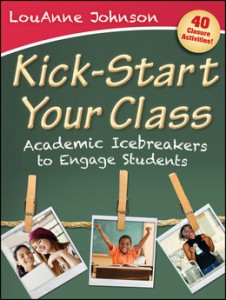Academic Icebreakers to Engage Students
Kick-Start Your Class: Academic Icebreakers to Engage Students
By LouAnne Johnson
(Jossey-Bass, 2012 – Learn more)

Kick-Start Your Class: Academic Icebreakers to Engage Students is a teacher’s dream come true. There are 125 icebreakers, along with 40 closure activities, all in one book! A smart administrator will purchase this book for the school’s professional library. A really smart administrator will model several of the icebreakers included in this book in faculty meetings.
In the Introduction, LouAnne Johnson points out the value of using icebreakers in any classroom. I agree with her completely; however, some of her icebreakers I might label as energizers or transitions. No matter the name, a teacher is guaranteed to find activities to engage students! Not only has Johnson done research on the brain, movement and learning, she has had first-hand success working with students – even “hardcore at-risk students in three different states.”
Skim for suitable icebreakers
A reader does not have to begin with the first activity and read straight through to the last activity. However, the Introduction is required reading! Johnson sets the stage there for using this three-part collection of activities to engage students in learning.

• Sticking to the Subject focuses on activities for Math, Science, Language Arts, Reading, Social Studies, Technology, Art, Music, and English Language Learners (ELLs).
• In the final section, Forty Ways to Wrap It Up, Johnson suggests 20 activities to use for daily closure and 20 activities for the end-of-term closure. While readers will recognize many of the icebreakers, they can certainly find new activities to add to their repertoire. And it’s nice to have them in one place.
The format for each Icebreaker is consistent: Purpose — Time — Ages — Materials –Preparation — Instructions for Students — Follow-Up — and in some cases, Variations. I do not always concur with the suggested time frame or age range, but I do appreciate having the author’s suggestions for how to present each icebreaker.
Preparation can be as simple as rearranging furniture or assigning partners or groups. However, watch out! Preparation can become quite involved in some activities. One example is Activity 13, Right or Left Brain?, where teachers need to read online research, then copy and paste a brain hemisphere preference quiz, create two posters, and create two sheets of easel paper.
Attention getters
Johnson tells readers in the Introduction to “create an attention getter” that the teacher will use consistently to alert students that it’s time to focus. She relates her personal experience of trying several attention getters (e.g., slapping a ruler on desk, clearing her throat, and body language designed to get students’ attention). While she now uses a rainstick, she encourages teachers to match their attention-getting device to their personalities and their particular students. Johnson provides step-by-step suggestions for teaching your chosen signal. (Read pages xix – xxi of the Introduction carefully.) Throughout the book, she reminds teachers “Demonstrate your Attention Getter.”
Part One: Getting Personal
The activities in Chapter 1 are designed to “engage students, make them feel welcome, and allow them to mingle and interact in a nonthreatening, nonstressful environment.” Teachers can certainly find appropriate Start-of-School activities in Chapters 1 and 3. The activities in Chapter 2 focus on assigning pairs and partners. Since the majority of the icebreakers are chance activities, I fear I could end up with some non-productive groups.
Two of my favorite activities are found in Chapter 4: Class Chant and Call-and Response. Although the icebreakers found in Chapter 5 encourage laughter and teamwork, I am not sure I could justify using instructional time for them.
Part Two: Sticking to the Subject
For me, this is the best part of the book since it deals with academics. Math activities found in Chapter 6 like Matchstick Puzzles (#61) encourage thinking and problem solving in a non-threatening manner. Chapter 7 features academic icebreakers for science. It’s Elemental (# 67) can be used to review previously taught material, and it can be extended to include research (as noted in the Variations).
Any teacher who teaches a 90-minute or 120-minute class (no matter the content) can find ideas in Chapter 8,The Language Arts Starters. For example, A Picture Tells a Hundred Words (#74) requires students to study a picture and create a list of words that come to mind when looking at the picture. That’s easy to implement in science or social studies. Meaningful Matches (# 79), Pictographs (#83), and Quotations (#86) can all be made content-specific. Chapter 9, Rev Up The Reading, will help create a love of reading among your students. Activities #89, #90 and #91 can all be adapted to any content and made more rigorous to meet the individual needs of all students.
Just when I thought it couldn’t get any better, I found the Social Studies Scenarios in Chapter 10. Birthday Customs (#95) is sure to be a hit with any age. I might skip using the balloons, but researching birthday customs and traditions is a great project. World View (#101) will work well for teaching and/or reinforcing visual literacy.
Various paper/pencil activities are presented in the Technology Chapter; be aware that these activities require computers and some preparation on the part of the teacher. Fortunately, Johnson provides clear, concise instructions for those of us who might require additional technical support. Activities for art and music are found in Chapters 12 and 13. This section of Academic Icebreakers closed with suggestions for using them with English Language Learners. Take a Note (#125), which involves dictation, ends with the author’s personal note about how successful this activity can be.
The final two chapters, What We Learned Today and Recapping the Course, focus on summarizing, predicting, evaluating, and reflecting.
An excellent resource
The activities in Kick-Start Your Class support teachers in engaging students while meeting the high demands of Common Core State Standards — two major concerns of educators in schools today. Johnson’s book will be welcomed by teachers in a many different grades and settings who are looking for a kick-start to learning.
Anne Anderson finally got out of the 8th grade after 24 years and 9 weeks! She spent the next 9 years sharing her expertise in literacy and writing with K-12 teachers and administrators throughout the district. She credits National Writing Project and Poetry Alive! as turning points in her growth as a teacher. Check out her fun series of middle grades activity books: Calendar Celebrations.



































